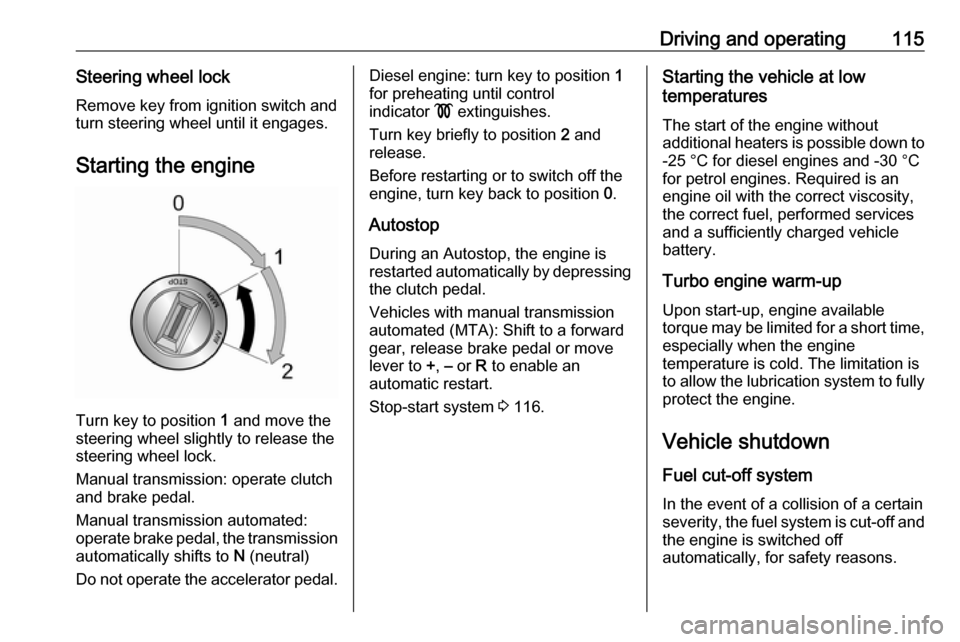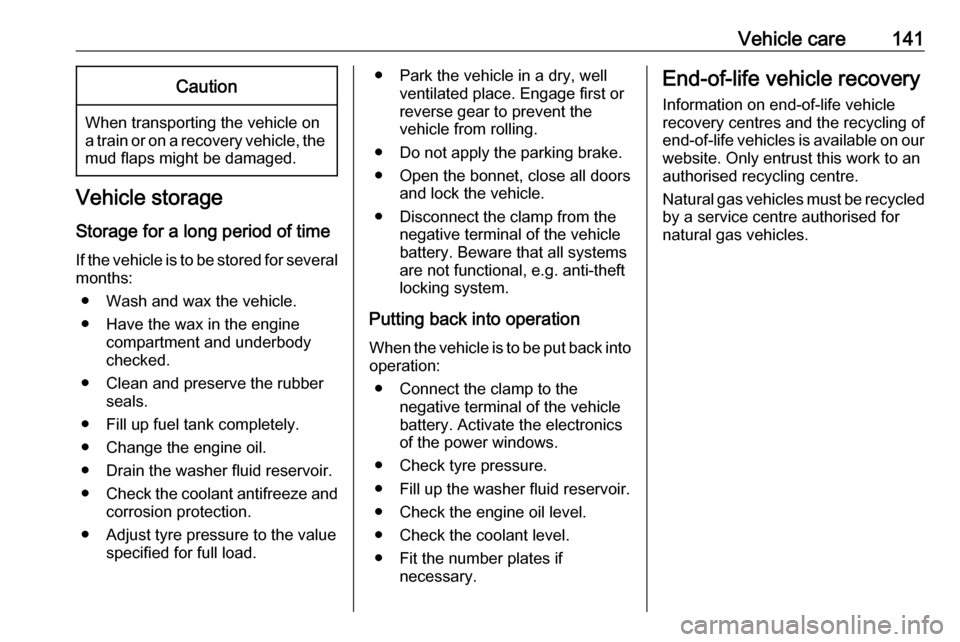service OPEL COMBO D 2017.5 Manual user
[x] Cancel search | Manufacturer: OPEL, Model Year: 2017.5, Model line: COMBO D, Model: OPEL COMBO D 2017.5Pages: 201, PDF Size: 4.76 MB
Page 117 of 201

Driving and operating115Steering wheel lockRemove key from ignition switch and
turn steering wheel until it engages.
Starting the engine
Turn key to position 1 and move the
steering wheel slightly to release the
steering wheel lock.
Manual transmission: operate clutch
and brake pedal.
Manual transmission automated:
operate brake pedal, the transmission
automatically shifts to N (neutral)
Do not operate the accelerator pedal.
Diesel engine: turn key to position 1
for preheating until control
indicator ! extinguishes.
Turn key briefly to position 2 and
release.
Before restarting or to switch off the
engine, turn key back to position 0.
Autostop During an Autostop, the engine is
restarted automatically by depressing
the clutch pedal.
Vehicles with manual transmission
automated (MTA): Shift to a forward
gear, release brake pedal or move
lever to +, – or R to enable an
automatic restart.
Stop-start system 3 116.Starting the vehicle at low
temperatures
The start of the engine without
additional heaters is possible down to -25 °С for diesel engines and -30 °C
for petrol engines. Required is an engine oil with the correct viscosity,
the correct fuel, performed services
and a sufficiently charged vehicle
battery.
Turbo engine warm-up Upon start-up, engine available
torque may be limited for a short time, especially when the engine
temperature is cold. The limitation is
to allow the lubrication system to fully
protect the engine.
Vehicle shutdown
Fuel cut-off system In the event of a collision of a certain
severity, the fuel system is cut-off and
the engine is switched off
automatically, for safety reasons.
Page 143 of 201

Vehicle care141Caution
When transporting the vehicle on
a train or on a recovery vehicle, the
mud flaps might be damaged.
Vehicle storage
Storage for a long period of time
If the vehicle is to be stored for several months:
● Wash and wax the vehicle.
● Have the wax in the engine compartment and underbody
checked.
● Clean and preserve the rubber seals.
● Fill up fuel tank completely.
● Change the engine oil.
● Drain the washer fluid reservoir.
● Check the coolant antifreeze and
corrosion protection.
● Adjust tyre pressure to the value specified for full load.
● Park the vehicle in a dry, wellventilated place. Engage first or
reverse gear to prevent the
vehicle from rolling.
● Do not apply the parking brake.
● Open the bonnet, close all doors and lock the vehicle.
● Disconnect the clamp from the negative terminal of the vehicle
battery. Beware that all systems
are not functional, e.g. anti-theft
locking system.
Putting back into operation
When the vehicle is to be put back into operation:
● Connect the clamp to the negative terminal of the vehicle
battery. Activate the electronics
of the power windows.
● Check tyre pressure.
● Fill up the washer fluid reservoir.
● Check the engine oil level.
● Check the coolant level.
● Fit the number plates if necessary.End-of-life vehicle recovery
Information on end-of-life vehicle
recovery centres and the recycling of
end-of-life vehicles is available on our website. Only entrust this work to an
authorised recycling centre.
Natural gas vehicles must be recycled by a service centre authorised for
natural gas vehicles.
Page 164 of 201

162Vehicle careGeneral information
The use of tyre chains or
commercially available liquid tyre
repair kits can impair the function of
the system. Factory-approved tyre
repair kits can be used.
Tyre repair kit 3 163, Tyre chains
3 163.
Operating electronic devices or being
close to facilities using similar wave
frequencies could disrupt the tyre
pressure monitoring system.
Each time the tyres are replaced, tyre pressure monitoring system sensors
must be dismounted and serviced by
a workshop.
Tread depthCheck tread depth at regular
intervals.
Tyres should be replaced for safety
reasons at a tread depth of 2-3 mm
(4 mm for winter tyres).
For safety reasons, it is
recommended that the tread depth of
the tyres on one axle should not vary
by more than 2 mm.
The legally permissible minimum
tread depth (1.6 mm) has been
reached when the tread has worn
down as far as one of the tread wear
indicators (TWI). Their position is
indicated by markings on the
sidewall.
If there is more wear at the front than
the rear, swap round front wheels and
rear wheels periodically. Ensure that
the direction of rotation of the wheels
is the same as before.
Tyres age, even if they are not used.
We recommend tyre replacement
every six years.
Changing tyre and wheel
size
If tyres of a different size than those
fitted at the factory are used, it may be necessary to reprogramme the
speedometer as well as the nominal
tyre pressure and make other vehicle modifications.
After converting to a different tyre
size, have the label with tyre
pressures replaced.9 Warning
Use of unsuitable tyres or wheels
may lead to accidents and will
invalidate the vehicle type
approval.
Wheel covers
Wheel covers and tyres that are
factory approved for the respective
vehicle and comply with all of the
relevant wheel and tyre combination requirements must be used.
If the wheel covers and tyres used are
not factory approved, the tyres must
not have a rim protection ridge.
Page 178 of 201

176Service and maintenanceService and
maintenanceGeneral information ...................176
Service information ..................176
Recommended fluids, lubricants
and parts .................................... 177
Recommended fluids and lubricants ................................ 177General information
Service information In order to ensure economical and
safe vehicle operation and to
maintain the value of your vehicle, it
is of vital importance that all
maintenance work is carried out at the proper intervals as specified.
The detailed, up-to-date service
schedule for your vehicle is available
at the workshop.
Service display 3 78.
Engine identification 3 180.
European service intervals Petrol and CNG engines
Maintenance of your vehicle is
required every 30,000 km or
two years, whichever occurs first.
Diesel engines
Maintenance of your vehicle is
required every 35,000 km or
two years, whichever occurs first,
unless otherwise indicated in the
Driver Information Centre 3 90.A shorter service interval can be valid
for severe driving behaviour, e.g. for
taxis and police vehicles.
Service display 3 78.
International service intervals
Maintenance of your vehicle is
required every 20,000 km or after one year, whichever occurs first,unless otherwise indicated by the
service display.
The international service intervals are valid for:
Albania, Belarus, Bosnia-
Herzegovina, Georgia, Macedonia,
Moldova, Montenegro, Serbia,
Ukraine.
Severe operating conditions exist if
one or more of the following
circumstances occur frequently: Cold
starting, stop and go operation, trailer operation, mountain driving, driving
on poor and sandy road surfaces,
increased air pollution, presence of
airborne sand and high dust content,
driving at high altitude and large
variations of temperature. Under
these severe operating conditions,
Page 179 of 201

Service and maintenance177certain service work may be requiredmore frequently than the regular
service interval.
Service display 3 78.
Confirmations
Confirmation of service is recorded in the Service and warranty booklet.
The date and mileage is completed
with the stamp and signature of the servicing workshop.
Make sure that the Service and
warranty booklet is completed
correctly as continuous proof of
service is essential if any warranty or goodwill claims are to be met, and is
also a benefit when selling the
vehicle.
Service interval with remaining
engine oil life duration
The service interval is based on
several parameters depending on
usage.
When the engine oil requires
changing, control indicator I will
flash in the instrument cluster 3 88.Depending on version, a message
may also appear in the Driver
Information Centre 3 90.
Service display 3 78.Recommended fluids,
lubricants and parts
Recommended fluids andlubricants
Only use products that meet the
recommended specifications.9 Warning
Operating materials are
hazardous and could be
poisonous. Handle with care. Pay
attention to information given on
the containers.
Engine oil
Engine oil is identified by its quality
and its viscosity. Quality is more
important than viscosity when
selecting which engine oil to use. The oil quality ensures e.g. engine
cleanliness, wear protection and oil
ageing control, whereas viscosity
grade gives information on the oil's
thickness over a temperature range.
Page 180 of 201

178Service and maintenanceDexos is the newest engine oil quality
that provides optimum protection for
petrol and diesel engines. If it is
unavailable, engine oils of other listed qualities must be used.
Recommendations for petrol engines
are also valid for Compressed Natural
Gas (CNG) fuelled engines.
Select the appropriate engine oil
based on its quality and on the
minimum ambient temperature
3 181.
Topping up engine oil
Engine oils of different manufacturers and brands can be mixed as long as
they comply with the required engine
oil quality and viscosity.
Use of engine oil with only
ACEA A1/B1 or only A5/B5 quality is
prohibited, since it can cause long-
term engine damage under certain
operating conditions.
Select the appropriate engine oil
based on its quality and on the
minimum ambient temperature
3 181.Additional engine oil additives
The use of additional engine oil
additives could cause damage and
invalidate the warranty.
Engine oil viscosity
The SAE viscosity grade gives
information on the thickness of the oil.
Multigrade oil is indicated by two
figures, e.g. SAE 5W-30. The first
figure, followed by a W, indicates the
low temperature viscosity and the
second figure the high temperature
viscosity.
Select the appropriate viscosity grade depending on the minimum ambient
temperature 3 181.
All of the recommended viscosity
grades are suitable for high ambient
temperatures.
Coolant and antifreeze
Use only antifreeze approved for the
vehicle. Consult a workshop.
The system is factory filled with
coolant designed for excellent
corrosion protection and frost
protection down to approx. -28 °C. In
regions with very low temperatures,the factory filled coolant provides frost
protection down to approx. -37 °C.
This concentration should be
maintained all year round.
The use of additional coolant
additives that intend to give additional
corrosion protection or seal against
minor leaks can cause function
problems. Liability for consequences
resulting from the use of additional coolant additives will be rejected.
Washer fluid
Use only washer fluid approved for
the vehicle to prevent damage of
wiper blades, paintwork, plastic and
rubber parts. Consult a workshop.
Brake and clutch fluidOver time, brake fluid absorbs
moisture which will reduce braking
effectiveness. The brake fluid should therefore be replaced at the specified interval.
Page 183 of 201

Technical data181Vehicle data
Recommended fluids and lubricants
Required engine oil qualityEngine oil quality: Europedexos 2✔
For countries with International
service interval 3 176, you may use
the oil qualities listed below:
Engine oil quality: Internationaldexos 2✔ACEA C3✔ACEA A3/B4✔Engine oil viscosity gradesAmbient temperaturedown to -25 °CSAE 5W-30 or
SAE 5W-40below -25 °CSAE 0W-30 or
SAE 0W-40
Page 194 of 201

192Customer informationStitcher Inc.
Stitcher™ is a trademark of Stitcher,
Inc.Verband der Automobilindustrie e.V.
AdBlue ®
is a registered trademark of
the VDA.Vehicle data recording
and privacy
Event data recorders
Data storage modules in the
vehicle
A large number of electronic
components of your vehicle contain
data storage modules temporarily or
permanently storing technical data
about the condition of the vehicle,
events and errors. In general, this
technical information documents the
condition of parts, modules, systems
or the environment:
● operating conditions of system components (e.g. filling levels)
● status messages of the vehicle and its single components (e.g.
number of wheel revolutions /
rotational speed, deceleration,
lateral acceleration)
● dysfunctions and defects in important system components● vehicle reactions in particular driving situations (e.g. inflation ofan airbag, activation of the
stability regulation system)
● environmental conditions (e.g. temperature)
This data is exclusively technical and
helps identifying and correcting errors
as well as optimizing vehicle
functions.
Motion profiles indicating travelled
routes cannot be created with this
data.
If services are used (e.g. repair
works, service processes, warranty
cases, quality assurance),
employees of the service network
(manufacturer included) are able to
read out this technical information
from the event and error data storage
modules applying special diagnostic
devices. If required, you will receive
further information at these
workshops. After an error has been
corrected, the data is deleted from the error storage module or it is
constantly overwritten.
Page 197 of 201

195Chimes......................................... 95
Cigarette lighter ........................... 75
Climate control ............................. 16
Climate control systems .............106
Clock....................................... 72, 90
CNG............................................ 189
Collision damage repair ..............191
Control indicators.......................... 79
Control of the vehicle .................113
Controls ........................................ 70
Convex shape .............................. 30
Coolant and antifreeze ...............177
Cruise control ...................... 90, 130
Cupholders .................................. 61
D
Danger, Warnings and Cautions ...4
Date .............................................. 90
Daytime running lights ..........90, 100
Declaration of conformity ............191
Diesel particle filter ...............86, 120
Distance to next service ...............90
Door open .................................... 90
Doors ...................................... 26, 28
Drain fuel filter ............................. 89
Driver assistance systems ..........130
Driver Information Centre .............90
Driving characteristics and towing tips .............................. 138
Driving hints ................................ 113E
Eco mode (E).............................. 124
Electric adjustment ......................30
Electrical system......................... 154
Electronic climate control system 108
Electronic driving programmes ..124
Electronic Stability Control ..85, 129
Electronic Stability Control (ESC). 85
End-of-life vehicle recovery .......141
Engine compartment fuse box ...155
Engine coolant ........................... 144
Engine coolant temperature ........86
Engine coolant temperature gauge ....................................... 78
Engine data ............................... 182
Engine exhaust .......................... 120
Engine identification ...................180
Engine oil ...........143, 177, 181, 189
Engine oil pressure ......................87
ESC (Electronic Stability Control) 129
Event data recorders ..................192
Exit lighting ................................ 105
Extendable load compartment cover ................................... 63, 67
Exterior care .............................. 172
Exterior light ................................. 89
Exterior lighting ......................13, 99
Exterior mirrors ............................. 30F
Fault ........................................... 125
Fixed air vents ........................... 111
Fog light ....................................... 90
Fog lights ................................... 150
Folding front passenger seat ........38
Folding mirrors ............................. 31
Folding seats .......................... 41, 42
Front airbag system .....................52
Front fog lights ........................... 101
Front passenger seat Folding ...................................... 38
Table position ............................ 38
Front seats.................................... 36
Front storage ................................ 61
Front turn signal light ..................148
Fuel............................................. 134
Fuel consumption .........................90
Fuel consumption - CO 2-
Emissions ............................... 137
Fuel cut-off system .........81, 96, 115
Fuel for diesel engines ..............134
Fuel for natural gas operation ...134
Fuel for petrol engines ...............134
Fuel gauge ................................... 77
Fuel selector ................................ 77
Fuel system messages .........96, 115
Fuel tank ..................................... 189
Fuses ......................................... 154
Page 199 of 201

197OObject detection systems ...........131
Odometer ..................................... 76
Oil, engine .......................... 177, 181
Operating windows from outside ..32
Outside temperature ....................72
Overhead console .......................61
Overrun cut-off ........................... 116
P Parking ................................ 19, 119
Parking assist ............................ 131
Parking brake ............................ 127
Particulate filter ........................... 120
Payload......................................... 67
Pedals......................................... 113
Performance .............................. 185
Performing work ........................142
Pollen filter ................................. 111
Power outlets ............................... 74
Power steering fluid ....................144
Power windows ............................ 32
Preheating ................................... 86
Puncture ..................................... 165
R Radio Frequency Identification (RFID) ..................................... 193
Radio info ..................................... 90
Radio remote control ...................21
Rear doors ................................... 26Rear fog light ............................... 90
Rear fog lights ........................... 101
Rear parcel shelf .......................... 63
Rear seats .................................... 41
Rear storage ................................. 62
Rear windows .............................. 34
Rear window wiper/washer .......... 71
Recommended fluids and lubricants ........................ 177, 181
Refuelling ................................... 135 Registered trademarks ...............191
Remote control ............................. 21
Removing seats ............................ 42
Reversing lights .........................101
Ride control systems ..........128, 129
Roof bars ...................................... 62
Roof load ...................................... 67
Roof rack ............................. 67, 187
Roof racks .................................... 67
S Safety belts ................................... 45
Seat adjustment ....................... 7, 37
Seat belt ........................................ 8
Seat belt reminder .......................82
Seat belt reminder warning chime 90
Seat belts ..................................... 45
Seat folding .................................. 38
Seat heating ................................. 40
Seat position ................................ 36Second row seats ........................41
Selector lever ............................. 122
Service ............................... 111, 176
Service display ......................78, 90
Service information ....................176
Settings menu............................... 90
Side airbag system ......................53
Sidelights ...................................... 99
Side turn signal lights ................151
Sliding door .................................. 26
Sliding side door ........................... 26
Spare wheel ............................... 167
Speed limit warning chime............ 90
Speedometer ............................... 76
Standard display ........................... 90
Starting and operating ................114
Starting off ................................... 17
Starting the engine ............115, 122
Steering ...................................... 114
Steering wheel adjustment ......9, 70
Steering wheel controls ...............70
Stop engine .................................. 81
Stop-start system.................. 89, 116
Storage ......................................... 60
Storage compartments .................60
Sun visors .................................... 34
Symbols ......................................... 4